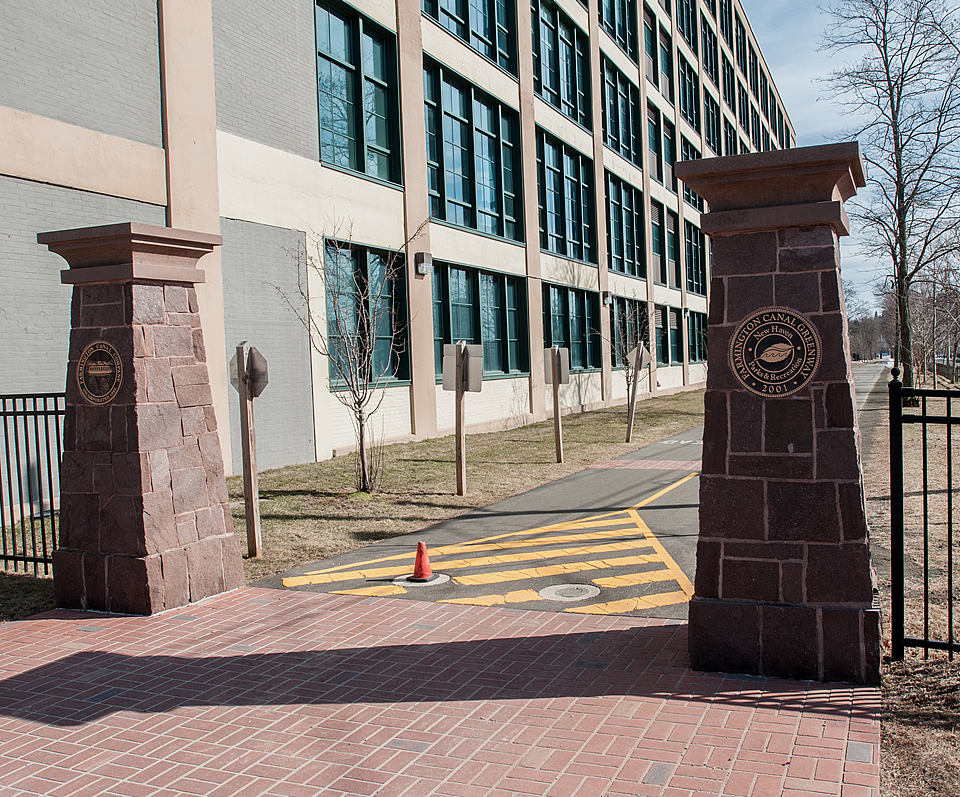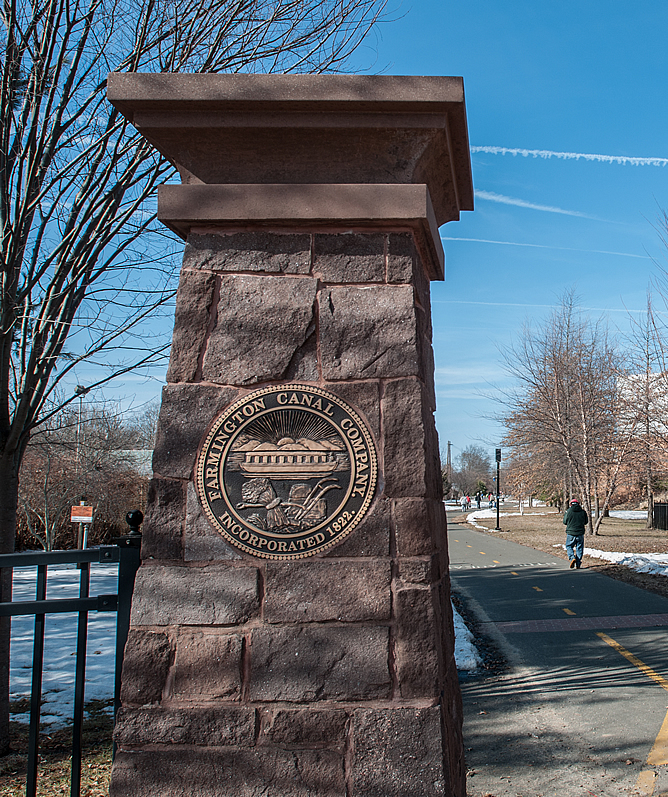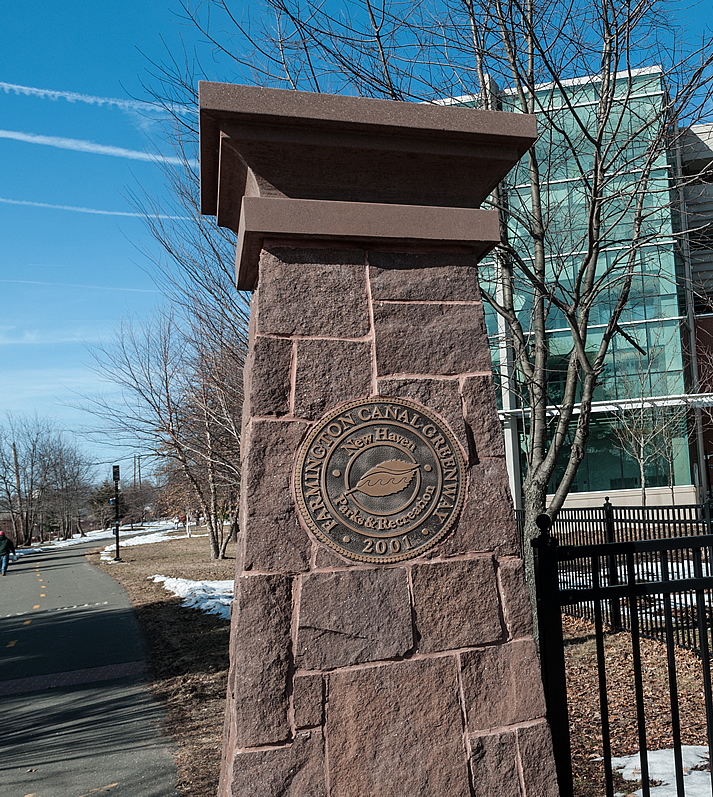

Canals were a transportation dream of the early Republic. George Washington called them "fundamental to nationhood" and was president of a canal company in Virginia. By 1790 canal companies had been founded in 8 of the original 13 states. On the heels of the completion of the Erie Canal in New York State, a group of New Haven businessmen met in 1821 with the goal of constructing a canal in Connecticut to facilitate trade. Ground was first broken on July 4, 1825. It was completed in 1835.
 Photo: View south of markers of Farmington Canal Trail on the south side of Henry Street near Science Park, site of the former Winchester Repeating Arms factory, in New Haven.. (Tod Bryant)
Photo: View south of markers of Farmington Canal Trail on the south side of Henry Street near Science Park, site of the former Winchester Repeating Arms factory, in New Haven.. (Tod Bryant)
 Photo: View north of west marker of Farmington Canal Trail on north side of Henry Street near Science Park, site of the former Winchester Repeating Arms factory, in New Haven.. (Tod Bryant)
Photo: View north of west marker of Farmington Canal Trail on north side of Henry Street near Science Park, site of the former Winchester Repeating Arms factory, in New Haven.. (Tod Bryant)
 Photo: View north of east marker of Farmington Canal Trail on north side of Henry Street near Science Park, site of the former Winchester Repeating Arms factory, in New Haven.. (Tod Bryant)
Photo: View north of east marker of Farmington Canal Trail on north side of Henry Street near Science Park, site of the former Winchester Repeating Arms factory, in New Haven.. (Tod Bryant)
The canal was dug by hand by mostly Irish laborers. The staid Yankee Congregationalists were astonished when 28 gangs of Irish immigrants, armed with picks and shovels, appeared along the proposed route. They labored in crews of 10 to 20 each. Their heavy brogues and rough appearance, coupled with the limitless capacity of some for hard liquor, caused consternation and resentment.
When, in 1832, a Catholic church was organized in New Haven to serve the Irish Catholics, an editorial in the local paper was headed, "The Pope's Coming!" The Irish were not welcome; they were objects of distrust and therefore isolated. Hired by contractors and subcontractors on the canal, they were the lowly, nameless diggers. Not only underpaid, the workers (as well as the contractors) were often paid late because of the company's teetering on insolvency. Sometimes, they were paid in scrip, redeemable at half the paper value.
However, the Irish canal workers also introduced ethnic diversity into these communities. They brought new customs and attitudes to the small towns, and in New Haven they formed the core of an Irish-American community which would later be swelled by immigrants of the Famine generation.
The canal was not cheap to build, and the finances of the construction and upkeep of the canal were always precarious. Railroads put an end to the use of the canal. Just 12 years after the canal was completed, a rail bed was laid to cover the same route the canal had traversed. The Canal Railroad remained in use until the early 1980's, when floods damaged the rail line to the point that it could no longer be used. Although there is still a small portion of the original rail line in use in Plainville, CT, the track was largely removed by 1987, and large portions of what had been the rail line were sold.
During the 1990's, construction on a trail, following the route of the original rail line was begun. The first sections were completed in northern Hamden and southern Cheshire, followed by extension southward in Hamden and northward in Cheshire. Around the same time, in the northern part of the state, efforts led to construction of a paved surface for recreation along the route of the old canal and rail road in Farmington, Avon, and Simsbury.
Today, the Farmington Canal Heritage Greenway covers a route of approximately 84 miles from New Haven, CT to Northampton, MA. Over half has been developed as a paved trail for non- motorized recreation and commuting.
"Farmington Canal Trail." Farmington Canal Rail to Trail Association.
[ view source ]
Grant, Ellsworth S. "The Ill-Fated Farmington Canal." CT Visit. http://www.ctvisit.com/travelstories/details/the-ill-fated-farmington-canal/88
[ view source ]
Raber, Michael S. and John Herzan. "Farmington Canal (New Haven and Northampton Canal)" National Register of Historic Places nomination. 1985.
Date(s): Built 1825-1835
Accessibility:
Exterior visible from public road.
The Irish experience has had a profound impact on Connecticut's past, and its narrative spans all periods of the state's history and touches every one of its eight counties and 169 towns.
